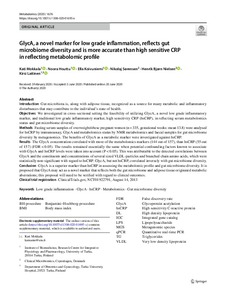GlycA, a novel marker for low grade inflammation, reflects gut microbiome diversity and is more accurate than high sensitive CRP in reflecting metabolomic profile
Kati Mokkala; Noora Houttu; Ella Koivuniemi; Nikolaj Sørensen; Henrik Bjørn Nielsen; Kirsi Laitinen
GlycA, a novel marker for low grade inflammation, reflects gut microbiome diversity and is more accurate than high sensitive CRP in reflecting metabolomic profile
Kati Mokkala
Noora Houttu
Ella Koivuniemi
Nikolaj Sørensen
Henrik Bjørn Nielsen
Kirsi Laitinen
SPRINGER
Julkaisun pysyvä osoite on:
https://urn.fi/URN:NBN:fi-fe2021042822222
https://urn.fi/URN:NBN:fi-fe2021042822222
Tiivistelmä
Introduction Gut microbiota is, along with adipose tissue, recognized as a source for many metabolic and inflammatory disturbances that may contribute to the individual's state of health.
Objectives We investigated in cross-sectional setting the feasibility of utilizing GlycA, a novel low grade inflammatory marker, and traditional low grade inflammatory marker, high sensitivity CRP (hsCRP), in reflecting serum metabolomics status and gut microbiome diversity.
Methods Fasting serum samples of overweight/obese pregnant women (n = 335, gestational weeks: mean 13.8) were analysed for hsCRP by immunoassay, GlycA and metabolomics status by NMR metabolomics and faecal samples for gut microbiome diversity by metagenomics. The benefits of GlycA as a metabolic marker were investigated against hsCRP.
Results The GlycA concentration correlated with more of the metabolomics markers (144 out of 157), than hsCRP (55 out of 157) (FDR < 0.05). The results remained essentially the same when potential confounding factors known to associate with GlycA and hsCRP levels were taken into account (P < 0.05). This was attributable to the detected correlations between GlycA and the constituents and concentrations of several sized VLDL-particles and branched chain amino acids, which were statistically non-significant with regard to hsCRP. GlycA, but not hsCRP, correlated inversely with gut microbiome diversity.
Conclusion GlycA is a superior marker than hsCRP in assessing the metabolomic profile and gut microbiome diversity. It is proposed that GlycA may act as a novel marker that reflects both the gut microbiome and adipose tissue originated metabolic aberrations; this proposal will need to be verified with regard to clinical outcomes.
Kokoelmat
- Rinnakkaistallenteet [27094]
